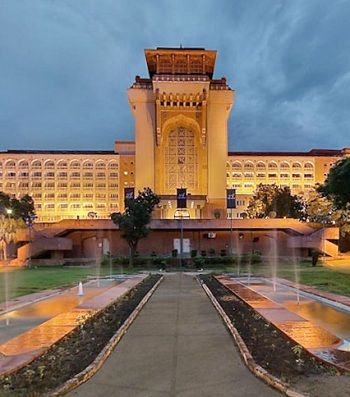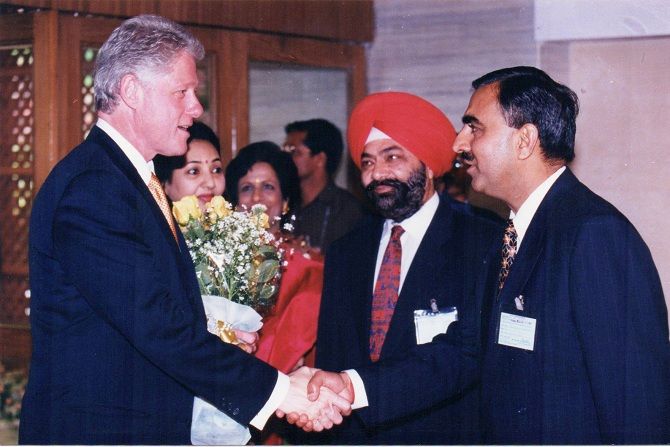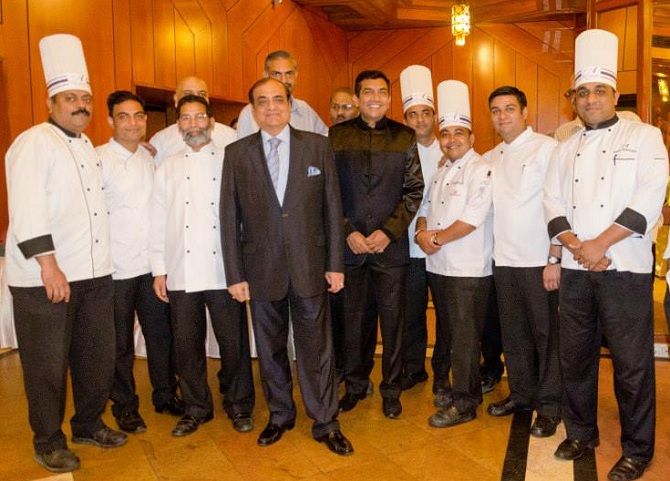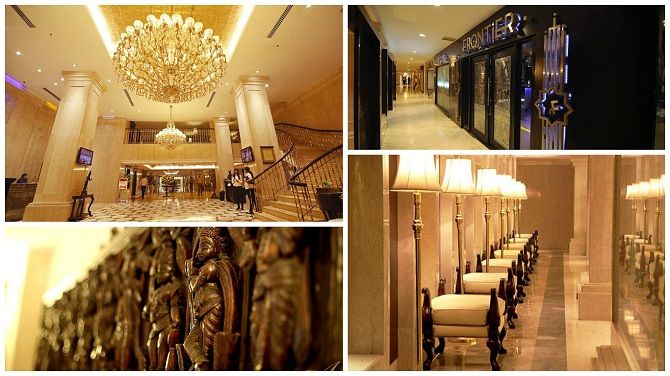 Nehru decided to build The Ashok in New Delhi to host a UNESCO conference. For a prime minister focussed on India building with projects like the Bhakra-Nangal Dam, IITs and factories, "the hotel spoke of the gumption of the country at that time."
Nehru decided to build The Ashok in New Delhi to host a UNESCO conference. For a prime minister focussed on India building with projects like the Bhakra-Nangal Dam, IITs and factories, "the hotel spoke of the gumption of the country at that time."
Manavi Kapur traces the eventful journey of the hotel, which has now completed 60 years.
The Ashok wears the scars of the myriad seasons of New Delhi, stains of time marring its once-pristine pink sandstone facade. It's still grand but no longer counts amongst the fanciest hotels in town. Yet, it was a labour of love for the country's founders.
In the 1950s, when the public sector had set out to acquire "commanding heights" of the economy, Jawaharlal Nehru, the newly-independent country's prime minister, decided to build a hotel to host the ninth UNESCO conference in New Delhi.
This hotel would host world leaders, besides the conference itself. It would be named Ashoka Hotel after one of India's great rulers.
It was also a time when the former rulers of princely states shared camaraderie with the government. For a project as ambitious as the Ashoka, a large tract of land was needed, and this is where the ex-royals came in. Fifteen of the original 23 shareholders of the hotel were erstwhile princes and even the bhoomi pujan was performed by Jam Saheb Digvijaysinghji of Nawanagar in 1955.
A Mumbai-based architect, B E Doctor, was entrusted the task of creating a hotel on the 25 acres of space. This included Delhi's largest pillar-less convention hall, 550 guest rooms and landscaped gardens. Doctor built a space that never went off-tangent from the historical and cultural symbols of the region. Jharokhas and jaali-work were added for a typically Rajput touch, in tribute to Indian royalty.
Since it opened its doors a year later in 1956, The Ashok -- it was rechristened in 2007 to uplift its profile -- has completed 60 years, battling many odds, economic volatility and changing regimes.
In their coffee-table book, The Ashok: Capital Icon, writers Hugh and Colleen Gantzer chronicle an interview of Sohan Lal, The Ashok's first and oldest tailor, who retired a few years ago. Lal recalls walking through a ridge to reach the site of the hotel in search of work. "There was only a path through the jungles then but everyone was working tirelessly… the workers, the supervisors, everyone," he tells the Gantzers in the book.
But even those who, unlike Lal, were perhaps not even born when The Ashok was built have stories to share. "It is almost like a rite of passage to hear these fascinating stories about the hotel's early days from the older staff," says Anmol Zutshi, resident manager at The Ashok.
One such story is of the time the building was being constructed. "Nehru, we are told, used to travel on horseback to oversee the construction," says Zutshi.
The prime minister of India even took the pains to watch over the planting of trees and flowers. This was when the hotel's first mango tree, too, came up. Known as the "pickle tree" today, it provides enough fruit for all jams and preserves in the hotel. Nehru and his vision are inseparable from the hotel's journey.
"It is only Nehru's vision that could have created a hotel as spectacular as The Ashok," says Habib Rehman, author, former managing director of ITC Hotels and the founder president of the Hotel Association of India.
This, adds Rehman, was a time when Nehru had already started dreaming of the Bhakra-Nangal dam, Indian Institute of Technology and Chandigarh as a model city. "The hotel spoke of the gumption of the country at that time, and for that, it was destined to be iconic."

Till about 1965, before The Oberoi burst on to the Delhi hospitality scene, The Ashok enjoyed uncontested cult status. The Imperial on Janpath and Maidens in Civil Lines were its only rivals. But even they could not match up to the sheer scale and grandeur of The Ashok.
"In those days, the hotel was still far out because Chanakyapuri was not in the heart of the city. And yet, loyalists such as my parents chose to stay at The Ashok," recalls Vir Sanghvi, journalist and food critic.
The charm in those early days was a European-style restaurant which had a large dining hall with one's room number written on a card and designated to a specific table. "It was only when The Oberoi opened its doors in Delhi in 1965, with its American-style service -- room service, standalone restaurants -- that the hospitality scenario in Delhi began to change."
Still, Sanghvi adds, it took a lot of convincing on his part to get his parents to even try staying at a hotel other than The Ashok.
Thirteen years later, the Taj Mahal Hotel would open on Mansingh Road and things would never be the same for The Ashok.
The other big change came with the establishment of the India Tourism Development Corporation in 1966, a body under the Union ministry of tourism, to own and manage The Ashok and other state-owned hotels. For the first 10 years, the original shareholders were fulfilling this role for The Ashok -- the advent of ITDC changed the ethos of the place.
While the struggle for survival was real, so was the commendable fight The Ashok put up. To change with changing times, the hotel in the 1970s opened what was one of Delhi's first nightclubs: The Supper Club. Singers Usha Uthup and Sharon Prabhakar were crooners here, several years before they went on to carve successful musical careers.
As is the case with most of the "younger" staff at the hotel, Asad Fayyaz, food and beverages manager, The Ashok, who has worked at the hotel for the last 30 years, recalls "those days" as if he were present. "It was one of the first multi-cuisine restaurants in the city with silver service, a live band and the lighting we now associate with discotheques." This was also where a scene from the Amitabh Bachchan-starrer Laawaris (1981) was shot.
The Supper Club ushered in an era of popular restaurants at The Ashok, including Rougenoir, Frontier, China Town, Tokyo and Burgundy. Rougenoir, in fact, was a French-specialty restaurant led by Chef Roger Moncourt who trained celebrity chef Sanjeev Kapoor and Rajan Loomba, the present chief executive chef at The Ashok.

Tokyo, a Japanese cuisine restaurant, was the crown jewel of the hotel in the '80s. "Unlike other hotels that imported chefs from various countries in the world, The Ashok sent its chefs to Japan to train under legendary chefs there," explains Loomba.
Ashok Kumar, Maitre D' Hotel and one of the oldest employees, recalls how working at Tokyo changed his life. "We were not just servers in the restaurant. We had to imbibe the Japanese way of life and culture," recalls Kumar. This, he says, taught him to be patient and calm, especially when serving a cantankerous guest.
The '80s were also the years when a lot of the bright, young chefs and managers were "poached" from The Ashok to newer hotels such as the Taj Mahal and Oberoi. But in a rare instance, The Ashok was able to lure ITC's Kharak Singh -- popular at the Bukhara restaurant for the daal -- for setting up Frontier, a North-West specialty restaurant.
Those were the glory days, when a young Shah Rukh Khan would nervously wait in the grand, brightly lit lobby of the hotel, to catch a glimpse of Yash Chopra and hope for a meeting with the director -- this was where the Bollywood director shot scenes for Chandni (1989).
And, going by the frequently shared stories, this is where industrialists met during every regime change to discuss policy and what it meant for them. "In a sprawling property like The Ashok, it was easy to be discreet and not be noticed," says Zutshi.
Going by Kumar's disdain for the "younger" guests today, it seems the number of such clients has significantly gone up. "We only serve liquor up to certain hour and men and women do not have the grace to accept rules," he says in hushed tones, shaking his head at "kids these days".
The younger clientele has, of course, been a result of Capitol, the nightclub at The Ashok that has been operational for over 10 years. Ironically, though, the Capitol came up in the spot where the hotel's in-house post office used to be.

Since The Ashok was the default hotel for government guests -- there was a rule that mandated all bureaucrats to stay at ITDC-owned properties -- eminent guests would sometimes make quirky demands that had to be met.
For instance, the hotel once replicated a dress that the laundry department had misplaced. The exact fabric was bought, stitched and handed over to the guest within three days. This was a rare feat considering a government-run hotel needs several rounds of permissions and paperwork for every little thing.
The most difficult customer, though, is Air India, members of the staff say in hushed tones. "They have permanent reservation of 150 rooms and their check-ins and check-outs are perhaps the hardest to handle," says a member of the staff.
The sarkari tag is, in many ways, the hotel's biggest enemy. Though managers and the staff suggest that it also works in favour of The Ashok -- there is a sense of security that comes with a government-run hotel -- the enthusiasm seems a bit overstated, all facts considered.
There was ample instability during 2002, when the National Democratic Alliance government was keen to sell The Ashok. Those who were employed at The Ashok at the time recall how their fate hung in the balance. Whether for its mammoth size or for the will to keep it in the ITDC stables, the government was unable to disinvest the hotel.
But, for observers like Sanghvi, this does not mean that all is well. "The hotel's story is a mirror-image of the Air India story, where the airline's decline began after the government replaced JRD Tata's management," he says.
In spite of the negative perception, The Ashok has been profitable for the last few years, especially because of its unparalleled conventional hall space. It is investing its profits in renovating the rooms and retaining its staff.
Rehman believes that it still has the potential to become the "Waldorf Astoria of India". And even though this might not be the end of the road for The Ashok, the "glory days" are still a distance away.











